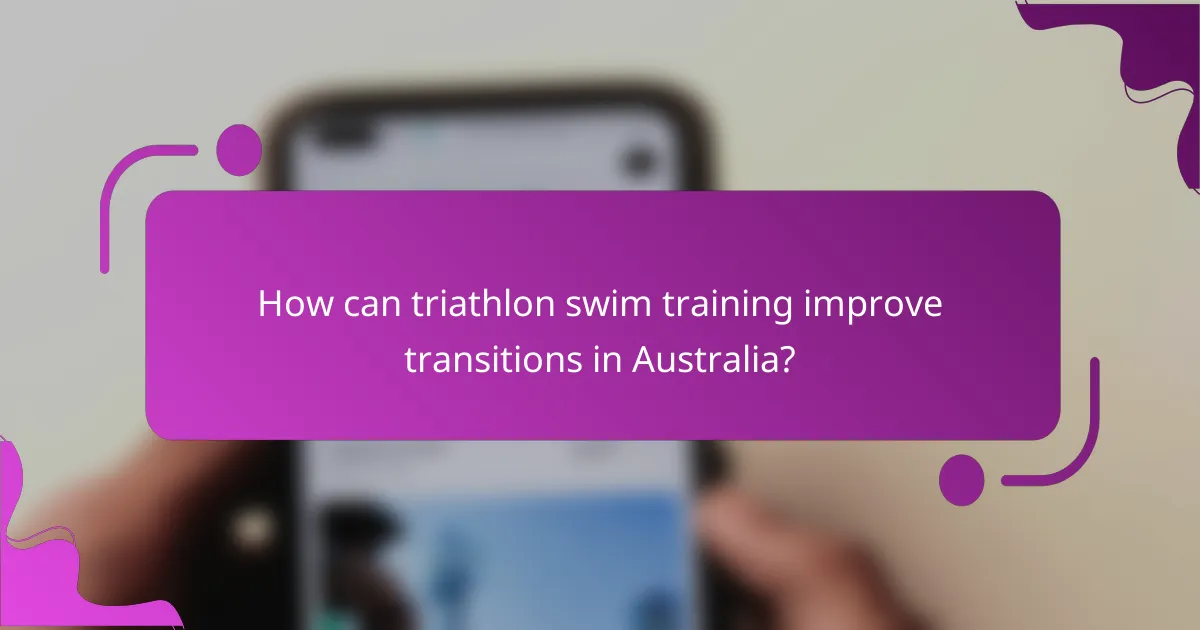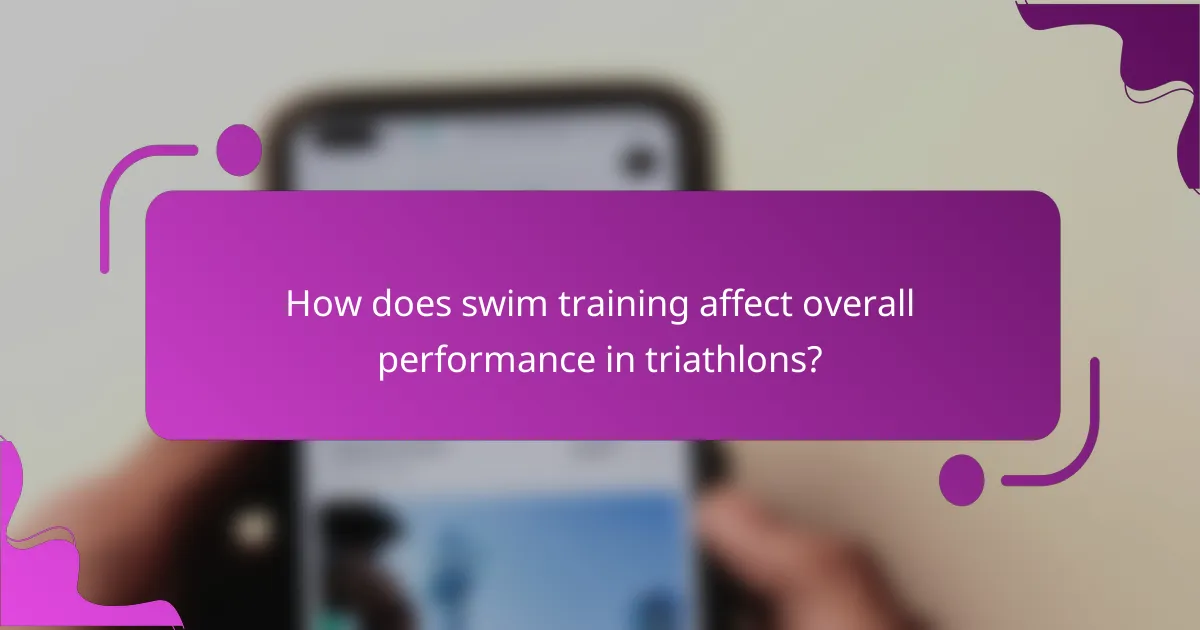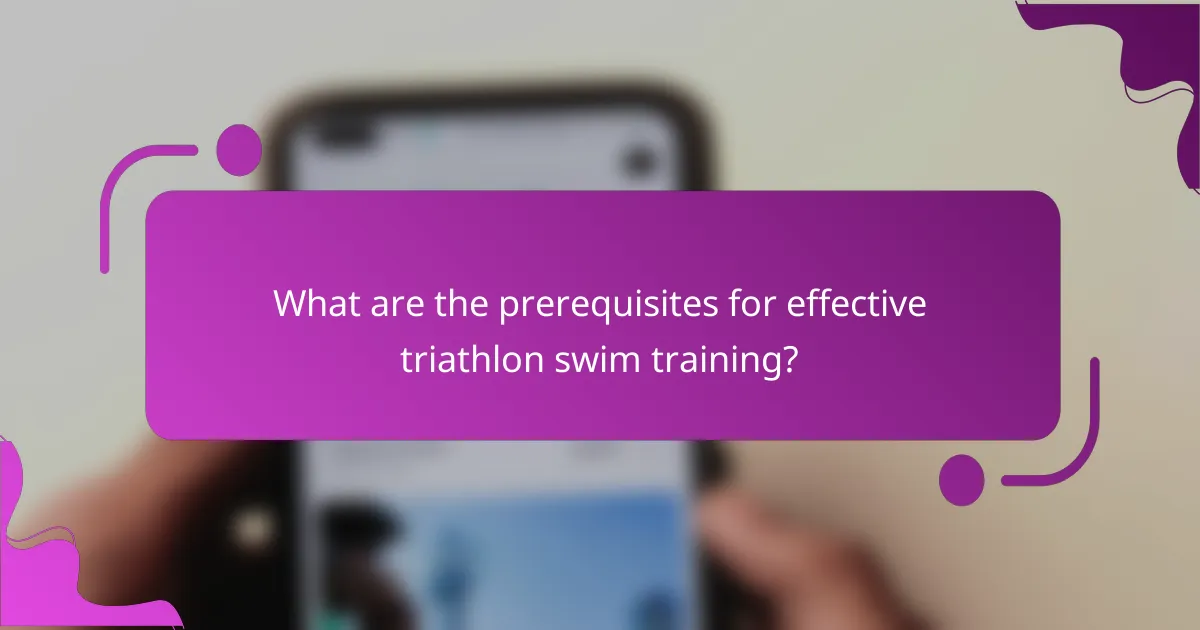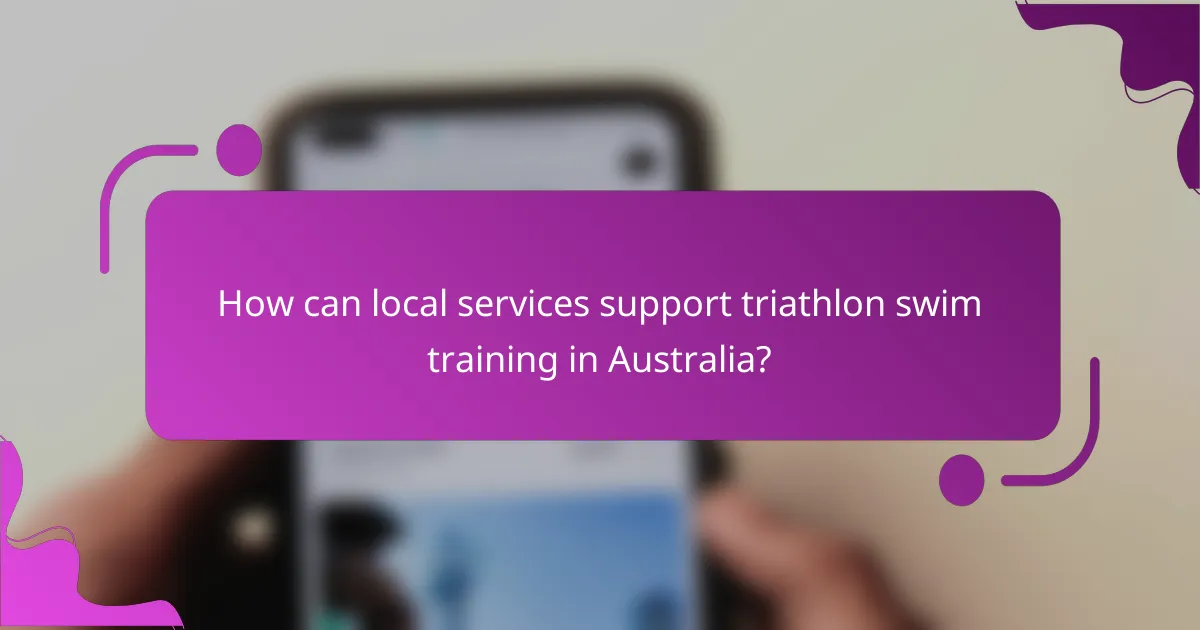Effective triathlon swim training plays a crucial role in enhancing overall performance by refining transitions, race strategies, and physical conditioning. By focusing on swim techniques, athletes can improve their pacing, drafting, and situational awareness, leading to quicker transitions and more efficient race execution. Ultimately, this targeted training results in faster race times and a competitive edge in triathlons.

How can triathlon swim training improve transitions in Australia?
Triathlon swim training can significantly enhance transitions by developing skills that streamline the shift from swimming to cycling. Improved techniques and strategies can lead to quicker, more efficient race performance, particularly in the competitive Australian triathlon scene.
Enhanced stroke efficiency
Improving stroke efficiency allows triathletes to swim faster while expending less energy. Techniques such as proper body positioning and effective arm movements can lead to smoother strokes, reducing drag in the water. Practicing drills focused on form can help athletes maintain a consistent pace throughout the swim leg.
Triathletes should aim for a stroke rate that balances speed and endurance, typically between 60 to 80 strokes per minute. Regular feedback from coaches or using video analysis can help identify areas for improvement.
Faster entry and exit techniques
Mastering entry and exit techniques is crucial for minimizing time spent in transitions. Athletes should practice diving into the water efficiently and quickly removing their wetsuits upon exiting. Techniques such as the “dolphin dive” can help athletes enter the water swiftly, while practicing the “sit-and-slide” method can speed up wetsuit removal.
Setting up a transition area that allows for easy access to gear and practicing these movements in training can significantly reduce transition times, often saving valuable seconds during a race.
Improved breathing patterns
Effective breathing patterns during swim training can enhance overall performance and comfort in the water. Triathletes should practice bilateral breathing to maintain balance and improve sighting during races. This technique allows for better navigation and reduces fatigue from overusing one side.
Incorporating breathing drills into training sessions can help athletes develop a rhythm that supports their stroke and reduces anxiety, especially in open water conditions typical in Australian triathlons.
Practice with wetsuits
Wetsuit practice is essential for acclimating to the buoyancy and resistance they provide. Triathletes should regularly train in their wetsuits to understand how they affect stroke mechanics and body position. This familiarity can lead to improved confidence and comfort during the swim leg.
Additionally, athletes should ensure their wetsuits fit properly and are suitable for the water temperatures they will encounter, as this can impact performance and comfort during races in Australia’s varying climates.

What race strategies can be developed through swim training?
Swim training can significantly enhance race strategies by improving pacing, drafting, transitions, and situational awareness. These elements contribute to a more efficient and competitive performance during triathlons.
Optimal pacing strategies
Effective pacing strategies are crucial for maintaining energy throughout the race. Swimmers should practice various pacing techniques during training, such as negative splits, where the second half of the swim is faster than the first. This approach helps in conserving energy for the bike and run segments.
To determine your optimal pace, consider conducting time trials in training. Aim for a pace that feels sustainable yet challenging, typically within a range of 70-85% of your maximum effort. Adjust your pacing based on conditions, such as water temperature and current.
Drafting techniques for open water
Drafting in open water can reduce energy expenditure by up to 30%. To effectively draft, position yourself directly behind or slightly to the side of another swimmer, taking advantage of their wake. This technique requires practice to maintain a safe distance while keeping pace.
During training, practice swimming in groups to develop your drafting skills. Be mindful of the race rules regarding drafting, as some events have specific regulations about how close you can swim to another competitor.
Transition planning
Transition planning is essential for minimizing downtime between swim and bike segments. Familiarize yourself with the transition area layout and practice your transitions during training sessions. Aim for a transition time of under two minutes for a competitive edge.
Consider organizing your gear efficiently, using a checklist to ensure you have everything you need. A common pitfall is overpacking; focus on essentials to streamline your transition process.
Situational awareness training
Situational awareness training enhances your ability to navigate the swim course effectively. This includes being aware of other swimmers, potential hazards, and environmental conditions. Regularly practicing in open water can help improve your comfort and responsiveness in these situations.
Incorporate drills that simulate race conditions, such as swimming in crowded environments or dealing with choppy water. Developing this awareness can prevent accidents and improve your overall race performance.

How does swim training affect overall performance in triathlons?
Swim training significantly enhances overall performance in triathlons by improving key physical attributes and mental skills. Focusing on swim training can lead to better transitions, effective race strategies, and ultimately, faster race times.
Increased endurance
Endurance is crucial for triathletes, as it allows them to maintain performance over longer distances. Swim training builds muscular endurance, enabling athletes to swim efficiently without fatigue. Regular practice can increase swim distances gradually, often aiming for sessions that last between 30 minutes to an hour.
To maximize endurance, incorporate interval training and longer, steady swims into your routine. This approach helps develop both aerobic capacity and muscular stamina, essential for the swim segment of a triathlon.
Improved cardiovascular fitness
Swim training enhances cardiovascular fitness, which is vital for overall triathlon performance. Engaging in swimming increases heart rate and improves blood circulation, leading to a stronger cardiovascular system. Athletes often notice improved recovery times and reduced fatigue during subsequent race segments.
To effectively boost cardiovascular fitness, aim for a mix of high-intensity interval training (HIIT) and longer, moderate-paced swims. This combination can elevate your aerobic threshold and prepare you for the demands of a triathlon.
Better mental resilience
Mental resilience is a key factor in triathlon success, and swim training can help develop this trait. Facing the challenges of swimming, such as cold water or crowded starts, builds confidence and mental toughness. Regularly pushing through difficult swim workouts can translate to improved focus and determination during races.
To cultivate mental resilience, set challenging swim goals and practice visualization techniques. This preparation can help you stay calm and composed during the race, especially in the swim leg where anxiety often peaks.
Enhanced speed in water
Improving speed in the water is essential for a competitive edge in triathlons. Swim training focuses on refining technique, stroke efficiency, and overall speed. Athletes can see significant improvements in their swim times with dedicated practice, often aiming to reduce their swim leg by several minutes.
Incorporate drills that focus on stroke mechanics, such as catch-up drills or sprint sets, to enhance speed. Additionally, using tools like paddles or fins can help develop strength and improve your overall swim performance.

What are the prerequisites for effective triathlon swim training?
Effective triathlon swim training requires a combination of basic swimming skills, access to suitable facilities, and an understanding of triathlon regulations. These prerequisites ensure that athletes can train efficiently and safely while preparing for their races.
Basic swimming proficiency
To participate in triathlon swim training, athletes must possess basic swimming proficiency. This includes the ability to swim at least a few hundred meters continuously and perform various strokes, primarily freestyle. A solid foundation in swimming techniques will enhance comfort and efficiency in the water.
Consider taking lessons or joining a swim club if you lack confidence in your swimming skills. Regular practice will help improve your endurance and speed, which are crucial for triathlon performance.
Access to local swim facilities
Having access to local swim facilities is essential for effective training. This could include public pools, lakes, or ocean areas designated for swimming. Facilities should ideally offer lap swimming times and be equipped with safety measures such as lifeguards.
Check the schedules of local pools to find times that fit your training routine. If open water swimming is part of your training, familiarize yourself with the local regulations and conditions to ensure a safe experience.
Knowledge of triathlon rules
Understanding the rules of triathlon is vital for effective swim training. Familiarity with regulations regarding swim gear, race formats, and transition procedures can significantly impact your performance. For instance, knowing whether wetsuits are allowed can influence your training approach.
Review the rules set by organizations like USA Triathlon or the International Triathlon Union, which outline the standards for equipment and conduct during races. This knowledge will help you avoid penalties and enhance your overall race strategy.

How can local services support triathlon swim training in Australia?
Local services in Australia can enhance triathlon swim training by offering tailored coaching and group sessions. These resources help athletes improve their swimming technique, transitions, and overall race performance.
Personalized coaching programs
Personalized coaching programs provide athletes with individualized training plans that focus on their specific strengths and weaknesses. Coaches assess swimmers’ techniques, endurance, and speed to create a structured approach that aligns with their race goals.
For example, a coach might work with a swimmer to refine their stroke efficiency, which can lead to significant time savings during races. Athletes should consider scheduling regular one-on-one sessions to track progress and adjust training as needed.
Group training sessions
Group training sessions foster a supportive environment where triathletes can practice swim techniques together. These sessions often include drills, pacing exercises, and open water practice, which are crucial for building confidence and skills in race-like conditions.
Participating in group training can also enhance motivation and accountability, as athletes push each other to improve. Local clubs in Australia frequently organize these sessions, making it easier for triathletes to find a community and stay committed to their training goals.
